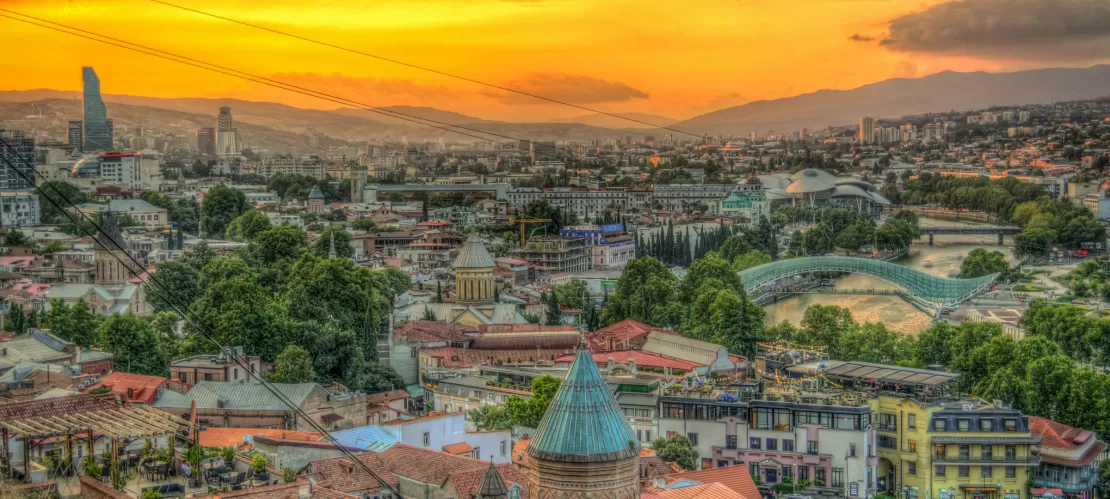
Snowy mountains, lush green fields, sparkling sea, sandy beach and desert open in front of your eyes all at once, just as you set foot in Georgia. This small but miraculous country can bewilder anyone with its beauty, as all four seasons and every possible landscape coexist together. While Erasmus students from all around the world may not know about Georgia’s existence, follow me, a local Georgian, on this journey, and write down your new favourite destination!
ㅤ
Georgia is a small country located on the border of Europe and Asia, making it multicultural and a mix of both continents. Although it is small, Georgia is separated into different regions, and each one of them has its own culture, extraordinary landmarks, and even three different Georgian languages. Let’s begin our journey from central Georgia, then travel North, South, and finally from West to East.

Central Part of Georgia
Georgia has always been known for its hospitality. It has embraced different cultures throughout its history, and Tbilisi is the product of this miracle. Tbilisi, one of the oldest cities in the world, is the capital city of Georgia. You cannot always see a synagogue, mosque and Christian church built next to each other and people talking in Arabic, Azerbaijani, Turkish and many other languages together. In the old parts of Tbilisi (Old Tbilisi), you can see the whole town built on mountain hills full of street vendors, colourful wooden houses and museums. On top of Old Tbilisi, Narikala Fortress, built in the 4th century, towers over the city with a picturesque panoramic view. Old Tbilisi was even a UNESCO World Heritage Site candidate. It is also well-known for natural sulfur baths, Abanotubani, with their unique domed roofs and historic spa culture. Once you visit, make sure to ask locals about the legend of how ‘Tbilisi’ (meaning ‘warm place’) was founded by King Vakhtang! You will certainly be surprised!
On the other side of the Mtkvari River, the Bridge of Peace separates Old Tbilisi from New Tbilisi. New Tbilisi is also an exciting place full of cafes, galleries and amusement parks. Funicular, you guessed it right, is also at the highest point of the mountain. It is the biggest amusement park full of different attractions and spring activities. If you want to escape into nature and go for a hike, you can visit the Funicular and also the Botanical Garden with a beautiful waterfall.
Right in the centre of Georgia, you can also visit Mtskheta, the old capital city of the Georgian kingdom, full of old historical houses and local markets. It is the country’s spiritual heart, a UNESCO World Heritage Site, rich in history and stunning religious landmarks. The city is sometimes referred to as ‘Little Jerusalem’. Mtskheta presents various monasteries like the Jvari Monastery, built in the 6th century on the hilltop overlooking the city; the Samtavro Monastery, where Saint Nino, who brought Christianity to Georgia, is said to have lived; and the Shio-Mgvime Monastery, located in a secluded gorge, known for its rock-hewn caves and ancient frescoes. Lastly, the Svetitskhoveli Cathedral, one of Georgia’s sacred churches, is famous for its legend. Don’t forget to learn why it was called ‘Svetitskhoveli’ (‘Living Stone’) and don’t miss out on traditional dishes like Mtsvadi (Georgian BBQ) and Churchkhela (Georgian ‘Snickers’).

The Northern Part of Georgia
ㅤ
The northern part of Georgia creates the scene of never-ending winter. Kazbegi is a mountainous town nestled in Georgia's Mtskheta-Mtianeti region, renowned for its breathtaking mountain landscapes. Here, Mount Kazbegi is a dormant volcano, 5,000 meters above sea level. If you are looking for adventures, then hiking to the Gergeti Glacier on the southeastern slopes of Mount Kazbegi will certainly amaze you. On top of the mountain slope, you can visit an iconic 14th-century church, the Gergeti Trinity Church. You can also explore the Truso Valley, known for its mineral springs and ancient towers. Once you get hungry, don’t forget to taste one of the most famous and traditional Georgian dumplings, Khinkali, there!
If Mount Kazbegi captured your heart, in the northwest, the Svaneti region will show a whole different, chivalrous side of Georgia. Svaneti offers dramatic mountain landscapes, medieval towers and unique traditions. Ushguli, a UNESCO World Heritage Site, showcases even greater views of Mount Shkhara, which can be accessed by hiking. Svan towers, where people still live, tell stories of medieval Georgia. While walking in the Svaneti region, you can see how people fought their enemies, what strategies they used and how people lived centuries ago. Tasting Svan cuisine such as Kubdari (meat-filled bread), Tashmijabi (cheesy mashed potatoes) and Svan salt (a special spice mix that every foreigner takes back home) is a must.
Southern Part of Georgia
In the south of Georgia, a mysterious aura captivates the visitors. In the Samtskhe-Javakheti region, Vardzia, a remarkable cave monastery complex carved into the slopes of the Erusheti Mountain along the left bank of the Kura River, holds Georgia's rich history and architecture. In the heart of Vardzia, Georgia’s medieval paintings are hidden, known for their portrait of King Tamar, the only woman ruler who was given the title of a king. Make sure to ask local monks about the legend connected to this place! Not far away, the Khertvisi Fortress, one of Georgia's oldest fortifications, reflects the region's strategic significance throughout history.

Western Part of Georgia
ㅤ
In the west of Georgia, the Black Sea and the mountains create an extraordinary mix in summer. Batumi, on the coast of the Black Sea, offers excellent entertainment for those who want to have fun, relax and learn a little about history. Strolling along the Batumi Boulevard features lush gardens, artistic sculptures and great nightlife. Along the way, the famous moving sculpture of Ali and Nino tells a story of two lovers from different cultures, symbolising unity and separation. Nearby, the Alphabetic Tower showcases unique Georgian script and towers over the city. In the Piazza Square nearby, inspired by European architecture and adorned with intricate mosaics, you’ll feel like you are in a whole different country. If you want your exchange in Georgia to be more about befriending new people and exploring some fun local places, Batumi can be the place for you! Once you are in Batumi, don’t forget to order this region’s famous dish, Acharuli khachapuri, a boat-shaped cheese bread. Ask what it symbolises, too!

Eastern Part of Georgia
ㅤ
You have already seen three parts of Georgia symbolising winter, summer and spring. Now it is time for the eastern part of Georgia, known for its magnificent autumn and never-ending feasts. The Kakheti region is the heart of Georgian wine production. This region boasts numerous wineries and family-run cellars where visitors can learn about traditional ‘qvevri’ winemaking, which is a UNESCO-recognised method, and sample a variety of local wines. Towns like Telavi and Kvareli serve as hubs for wine tourism, where you can take part in Rtveli, a traditional vintage harvest holiday in autumn, accompanied by feasts, musical events and other celebrations. It is no surprise that right in this region, you can also see the city of love, Sighnaghi, right on top of a hill overlooking the Alazani Valley. Sighnaghi is a charming city with its cobblestone streets, colourful houses and historic city walls.
What also adds to the colours of autumn is the David Gareji Monastery Complex, a Georgian Orthodox monastery partially carved into the cliffs, located along the semi-desert landscape near the Azerbaijani border. The complex comprises hundreds of cells, churches and chapels, many adorned with ancient frescoes. What is even more exciting is that the surrounding area has unique geological formations, often referred to as the ‘Rainbow Mountains’!
If it is your first time hearing about Georgia, I am sure you are now ready to mark your diary for your next trip and do the impossible–be in Europe and Asia at the same time! Living in Georgia as an exchange student is not pricey, and the language barrier in most places does not exist, as many Georgians speak English. ESN Georgia is waiting for visitors with great hospitality, a traditional feast full of Georgian cuisine, and every possible attraction you may wish for!
